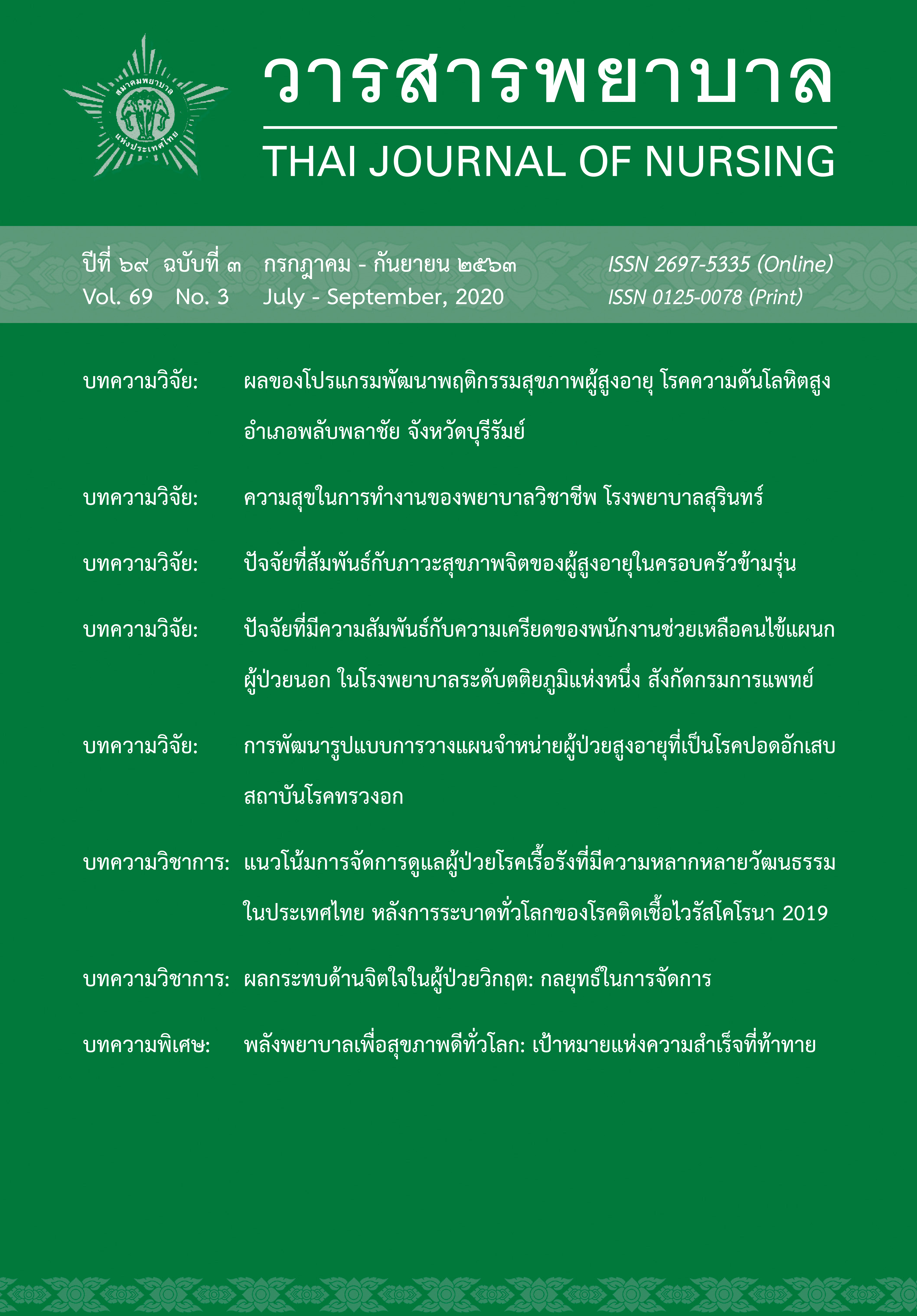Psychological impacts on patients with critical illness: Management strategies
Main Article Content
Abstract
Critical illness is life threatening and also one of the causes for patients to be admitted into the intensive care unit (ICU) where they need advanced medical technology, various medications to sustain and support their lives. These medical procedures eventually are associated with physical, psychological impacts on patients and their families. A number of negative impacts on the patients are excruciating pain, immobility, sleep disorder, stress, anxiety, and ICU delirium. With regard to the health of the patients in the ICU, and quality critical care has therefore been delivered through the efficient management of the critical care provider. The management strategies involve managing care with multi-discipline team, and using protocols “ FAST HUGS BID ” care model which include: 1) F: feeding; sufficient nutrients and fluid 2) A: Analgesia; pain management, 3) S: Sedation, 4) T: Thromboprophylaxis 5) H: Head-up, 6) U: Ulcer prophylaxis 7) G: Glycemic control, 8) B: Spontaneous breathing trial, 9) Bowel movement, 10) I: Indwelling catheter, and 11) D: Drug De-escalation. In addition, nurses should provide suitable environment, controlling noise, light, and providing information to families. Nurses should also work with the patients, trying to encourage their cognation, thinking, memory and orientation. Using implementation strategies can improve not only physical but also psychological health of patients. Therefore, these can reduce mortality rate, short ICU stay, and less cost of care.
Article Details
References
ผู้ป่วยมะเร็ง: การศึกษาเชิงปรากฏการณ์วิทยา. วารสารพยาบาลสงขลานครินทร์, 36(3), 23-32.
วิจิตรา กุสุมภ์. (2560). บทที่ 3 ภาวะจิตสังคมในผู้ป่วยวิกฤต. ใน วิจิตรา กุสุมภ์ (บก.). การพยาบาลผู้ป่วย
วิกฤตแบบองค์รวม (พิมพ์ครั้งที่ 6, น. 1-9). กรุงเทพมหานคร: สหประชาพาณิชย์.
สุนันทา ครองยุทธ. (2558). การจัดการภาวะสับสนเฉียบพลันของผู้ป่วยไอซียู. วารสารคณะพยาบาล
ศาสตร์ มหาวิทยาลัยบูรพา, 23(4), 89-99.
Bizek, K. S., & Fontaine, D. K. (2013). The patients experience with critical illness. In P. G. Morton
& D. K. Fontaine (Eds). Critical care nursing: A holistic approach (10th ed., pp.15-50).
Philadelphia: Lippincott William & Wilkins.
Bolosi, M. (2018). Depressive and anxiety symptoms in relatives of intensive care unit patients
and the perceived need for support. Journal of Neuroscience Rural Practice, 9 (4), 552-558.
Boodman, S. G. (2015, June 7). The overlooked danger of delirium in hospitals. The Atlantic,
Retrieved November 1, 2019, from http://www.theatlantic.com
Ciufo, D., Hader, R., & Holly, C. (2011). A comprehensive systematic review of visitation models in
adult critical care units within the context of patient and family centered care. International
Journal of Evidence Based Health Care, 9 (4), 362-387. doi: 10.1111/j.1744-71609.2011.00229.x
Delaney, L. J., Haren, F. V., & Lopez, V. (2015). Sleeping on a problem: The impact of sleep
disturbance on intensive care patients -a clinical review. Annals of Intensive Care, 5(3), 1-10..
doi: 10.1186/s13613-015-0043-2
Dias, D. S., Resende, M.V., & Diniz, G. C. (2015). Patient stress in intensive care: Comparison
between a coronary care unit and a general postoperative unit. Revista Brasileira de
Terapia Intensiva, 27(1), 18-25.
Erdogan, Z, & Atik, D. (2017). Complementary health approaches used in the intensive care unit.
Holistic Nursing Practice, 31(5), 325-342.
Iwuafor, A. A., Ogunsola, F. T., Oladele, R. O., Oduyebo ,O. O., Desalu, I., Egwuatu, C. C, . . .
Ogban, G. I. (2016). Incidence, clinical outcome and risk factors of intensive care unit
infections in the Lagos University teaching hospital (LUTH), Lagos, Nigeria. PLOS ONE,
11(10), e0165242.
Jayaswal, A. K., Sampath, H., Soohinda, G., & Dutta, S. (2019). Delirium in medical intensive care
units: Incidence, subtypes, risk factors, and outcome. Indian Journal Psychiatry, 61(4),
352-358.
Jantapo, A., & Kusoom, W. (2020). Lifestyle and cultural factors related to longevity among older
adults in the Northeast of Thailand. Journal of Transcultural Nursing, 26(2), 1-8.
doi: 10.1177/1043659620921225
Nair, A. S., Naik, V. M., & Rayani, B. K. (2017). FAST HUGS BID: Modified Mnemonic for Surgical
Patient. Indian Journal of Critical Care Medicine, 21(10), 713–714. doi: 10.4103/ijccm.IJCCM
_289_17
Schmidt, M., & Azoulay, E. (2012). Having a loved one in the ICU: the forgotten family. Current
Opinion in Critical Care,18(5), 540-547. doi: 10.1097/MCC.0b013e328357f141
Stien-Parbury, J. (2014). Neurocognitive Disorders. In M. J. Halter (ed.). Foundation of
psychiatric mental health nursing (pp. 432-478). St Louis: Elsevier.
Taylor, C. R., Lynn, P. B., & Barlett, J. L. (2019). Fundamentals of nursing: The art and science of
person-centered care (9thed.). Philadelphia: Wolters Kluwer.
Topçu, S., Alpar, E., Gulseven, B., & Kebapci, A. (2017). Patient experiences in intensive care
units: A systematic review. The Revista Brasileira de Terapia Intensiva, 27(1), 18–25.
Vincent, W. R., & Hatton, K. W. (2009). Critically ill patients need “ FAST HUGS BID ” (an
updated mnemonic). Critical Care Medicine, 37(7), 2326-2327.
doi: 10.1097/ccm.0b013e3181aabc29
Vlake, J. H., van Genderen, M. E., Schut, A., Verkade, M., Wils, E. J., Gommers, D., & van Bommel,
J. (2020). Patients suffering from psychological impairments following critical illness are in
need of information. Journal of Intensive Care, 8(6), 1-10. doi: 10.1186/s40560-019-0422-0
Wiseman, T. A., Curtis, K., Lam, M., & Foster, K. (2015). Incidences of depression, anxiety and
stress following traumatic injury: A longitudinal study. Scandinavian Journal of Trauma,
Resuscitation and Emergency Medicine, 23, 29. doi: 10.1186/s13049-015-0109-z


